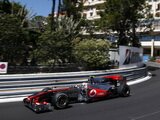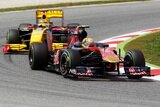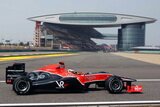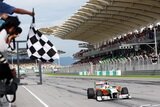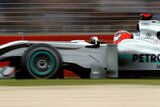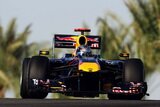As late as 1985 a typical Formula One helmet weighed around 2kg. That amount increased dramatically under high-G cornering or deceleration, adding to the risk of 'whiplash' type injuries in big accidents. As head and neck trauma has been identified as the greatest single risk of injury to race drivers, helmet manufacturers place the greatest importance on reducing the mass of helmets, while increasing their strength and resistance to impacts.
Current Formula One helmets are massively strong, and also considerably lighter, now weighing approximately 1.25 kg. Helmets are constructed from several separate layers, offering a combination of strength and flexibility (vital to absorb the force of large impacts). The outer shell has two layers, typically fibre-reinforced resin over carbon fibre. Under that comes a layer formed of vastly strong plastic, the same material used in many bullet-proof vests. Then there is a softer, deformable layer made from a plastic based on polystyrene, covered with the flame-proof material used in racing overalls and gloves.
The visor will be made of a special clear polycarbonate, combining excellent impact protection with flame resistance and excellent visibility. Most drivers use tinted visors, the insides of which are coated with anti-fogging chemicals to prevent them misting up, particularly in wet conditions. Several transparent tear-off strips are attached to the outside. As the visor picks up dirt during the course of the race, the driver can remove these to clear his vision.
In recent seasons the actual shape of helmets has gradually evolved, as more aerodynamically efficient shapes are brought into use. Sitting directly below the main engine air intake, helmets are increasingly shaped to assist in the process of reducing drag in this notoriously high-turbulence aerodynamic area. The modern designs also reduce the lift produced by more traditionally shaped helmets - which can be anything up to 15 kg at racing speeds.
The helmet design must also provide ventilation for the driver. This is achieved through the use of various small air intakes. To prevent small particles of track debris entering the helmet these intakes are equipped with special filters.
Despite the cutting edge materials used in their construction Formula One helmets are still painted by hand, an incredibly skilled job requiring hundreds of hours of work for more complicated patterns and designs. And most drivers will go through several helmets during the course of a season.
As you would expect, the FIA have strict ‘super helmet requirements for Formula One racing. To gain approval for Grand Prix use, a helmet design must pass a number of tests, covering factors such as crush and penetration resistance and surface friction. It must also work correctly in conjunction with the mandatory HANS (Head and Neck Support) device.
Comments:


